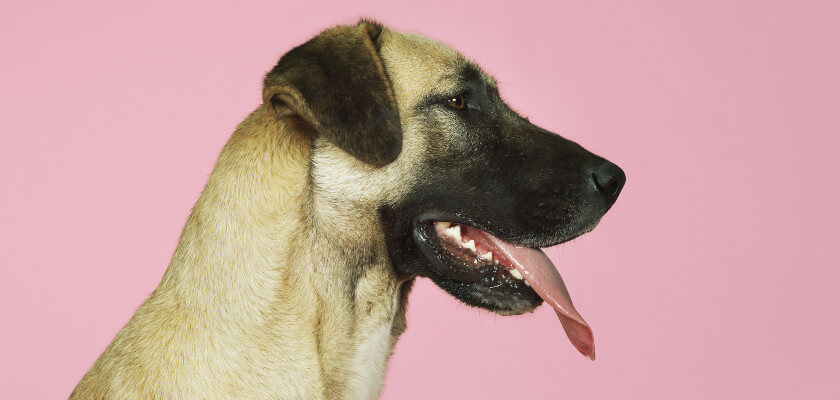The anatomy of a dog is an issue that is of primary interest to specialists – veterinarians, zootechnicians and cynologists. Meanwhile, basic information about the dog’s anatomy is also necessary for caregivers. If you have the appropriate knowledge, you have a chance to catch the symptoms of a potential disease quickly and early.
Dog anatomy – basic information
Dog anatomy is part of veterinary studies. This field of veterinary medicine focuses in detail on the structure of the animal’s body with all its systems and internal organs.
We divide anatomy into topographic and descriptive. The first one determines the position of individual organs, bones and muscles in relation to each other. The second, in turn, focuses on their operation and construction.
Dog’s skeleton – structure of the skeletal system
A specific scaffold of a dog’s body is its skeleton. The most common problems with the locomotor system in dogs are hip and elbow dysplasia. This disease significantly impairs the animal’s freedom of movement and is very painful, therefore its prevention is of great importance. Older animals may also develop discopathy and other spinal conditions.
Spine
The dog’s spine consists of seven cervical vertebrae, thirteen thoracic vertebrae, seven lumbar vertebrae, and three sacrum vertebrae. The number of tail vertebrae varies, but the standard number is around twenty.
Skull
The skull of a dog consists of:
- jaws,
- frontal bone,
- lacrimal bone,
- palatine bone,
- zygomatic bone,
- nasal bone,
- parietal bone,
- incisor bone,
- intra-epithelial bone,
- temporal bone,
- occipital bone,
- mandible.
Teeth
An adult dog has 42 teeth in total.
In the jaw:
- 2 fangs
- 6 incisors
- 4 premolars,
- 2 molars.
In the lower jaw:
- 2 fangs
- 6 incisors
- 4 premolars,
- 3 molars.
A scissor bite is most desirable. In shepherd dogs, the so-called tick bite is normal. Dogs, like humans, can also have malocclusions – for example, overshot or undershot (typical of brachycephalic breeds).
Zebra
A healthy dog should have 13 pairs of ribs to protect internal organs. 9 pairs connect to the sternum, and the remaining 4 form the costal arch.
The role of the ribs is very important – they protect delicate internal organs from mechanical damage.
Pelvis
A dog’s pelvis consists of fused bones:
- pubic,
- sciatic,
- hip.
The pelvis connects the spine with the hind legs. Its task is to protect sensitive internal organs – especially the bladder and intestines.
Of course, the size and length of individual bones are determined by racial issues and the individual characteristics of a given dog.
Dog anatomy – internal organs
The action of individual internal organs is responsible for maintaining the vital functions of the animal. In this respect, the build of a dog does not differ much from that of a human. The organs are arranged differently but fulfill the same functions:
- Trachea – made of cartilage tissue, drains air to the lungs.
- Lungs – Made of alveoli, they are located in the dog’s chest. Their task is to carry out gas exchange.
- Heart – pumps blood to all organs of the body. It beats 80 times a minute in large dogs and about 120 times a minute in smaller breeds.
- Stomach – in dogs it has a single chamber.
- Liver – neutralizes toxins and regulates the water balance. This is the largest gland in the dog’s body.
- Spleen – Located just below the diaphragm.
- Kidneys – remove waste products, are responsible for maintaining the fluid balance in the dog’s body.
- Intestine – consists of the duodenum, jejunum, iliac intestine and colon. It is the longest component of a dog’s digestive system.
- Urinary bladder and ureters – thanks to them, urine is removed from the body together with toxic substances.
The reproductive system of the dog
The structure of the dog’s reproductive system, as in all mammals, depends on the sex. In the case of bitches, it consists of:
- vulva,
- vaginas,
- cervix,
- body and horns of the uterus,
- fallopian tubes,
- ovaries.
The dog’s structure is as follows:
- foreskin,
- penis,
- moszna,
- testicles,
- prostate,
- vas deferens.
During the castration procedure in bitches, all appendages are removed, along with the uterus and ovaries. This procedure is often confused with sterilization, which consists only in ligation of the fallopian tubes.
The external anatomy of the dog
The head of a dog consists of the following elements:
- forehead,
- occipital tumor,
- nasada ucha,
- stop,
- kufa,
- trufla nosowa,
- lips,
- fafle,
- jaw.
Among the elements of the neck, torso and abdomen, we distinguish:
- podgardle,
- neck,
- withers,
- ridge,
- loins,
- root of the tail,
- tail,
- weakness,
- belly,
- parapet,
- chest,
- handle of the sternum,
- spatula.
The structure of a dog’s limbs includes:
- udo,
- shank,
- heel and heel tumor,
- metatarsus,
- paw,
- knee,
- elbow,
- wrist,
- metacarpus,
- forearm.
Why is it important to know the body structure of a dog?
The individual elements of a dog’s body structure may seem insignificant from the perspective of a standard caregiver. Meanwhile, knowing the basic anatomy of your pet can help you in many crisis situations.
Knowing your pet’s anatomy is not only important emotionally. If you have full knowledge about it, you will react faster when there is a change in it.
Dog anatomy – summary
The anatomy of a dog at an academic level is very complicated. However, mastering the basic structure of your pet shouldn’t be a particularly difficult task.
The roles of individual internal organs or the structure of the dog’s skeleton are elementary knowledge that will certainly be useful to every caregiver.

